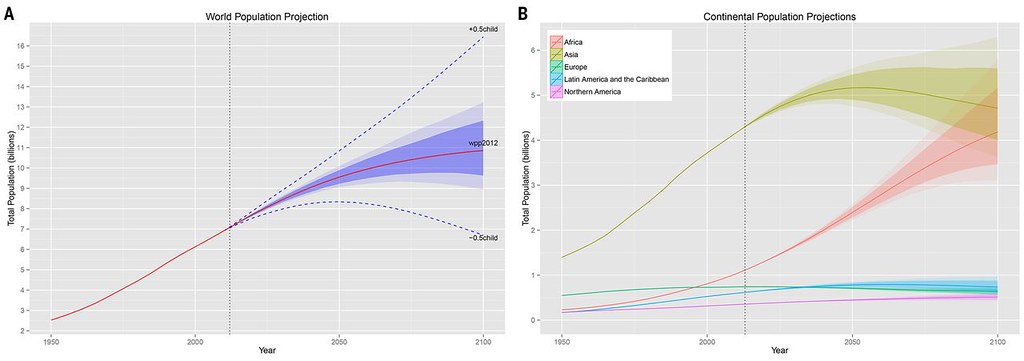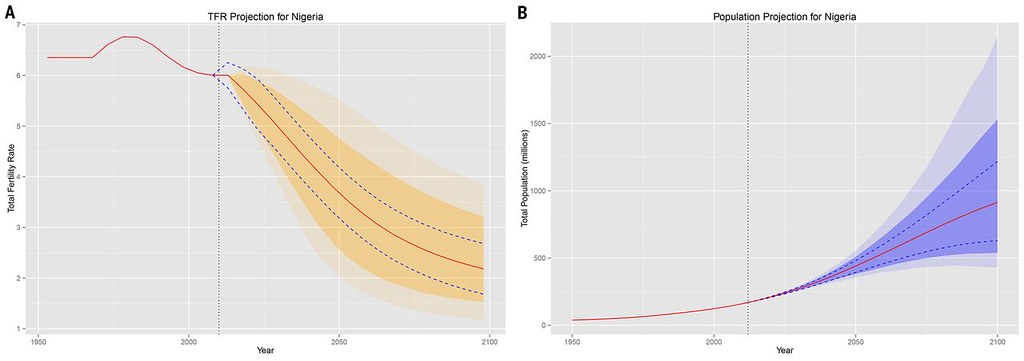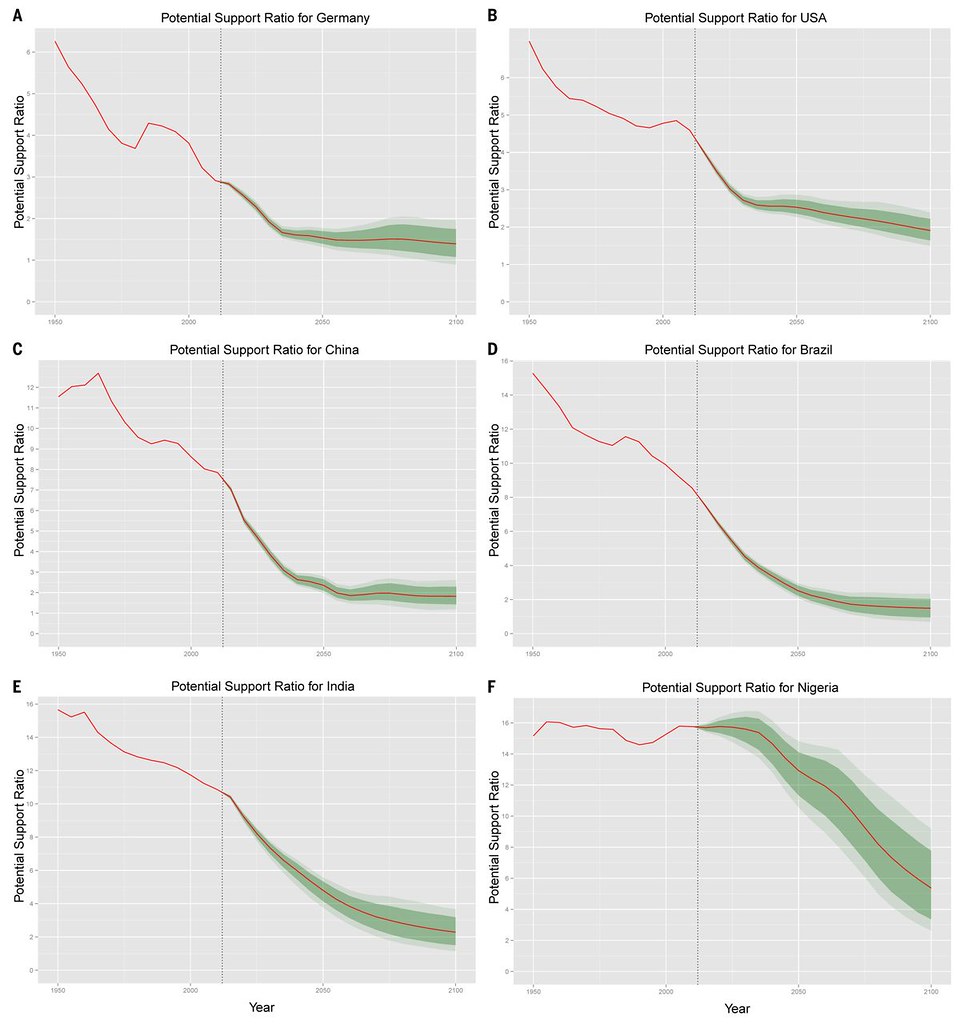Por Sérgio Teixeira Jr. - ReSet - 12 de novembro de 2024 - Decisão adotada no…
World population stabilization unlikely this century
Abstract
The United Nations recently released population projections based on data until 2012 and a Bayesian probabilistic methodology. Analysis of these data reveals that, contrary to previous literature, world population is unlikely to stop growing this century. There is an 80% probability that world population, now 7.2 billion, will increase to between 9.6 and 12.3 billion in 2100. This uncertainty is much smaller than the range from the traditional UN high and low variants. Much of the increase is expected to happen in Africa, in part due to higher fertility and a recent slowdown in the pace of fertility decline. Also, the ratio of working age people to older people is likely to decline substantially in all countries, even those that currently have young populations.
The United Nations (UN) is the leading agency that projects world population into the future on a regular basis (1). Every two years it publishes revised data of the populations of all countries by age and sex, as well as fertility, mortality and migration rates, in a biennial publication called the World Population Prospects (WPP) (2). In July 2014, probabilistic projections for individual countries to 2100 were released Unlike previous projections, they allow us to quantify our confidence in projected future trends using established methods of statistical inference. They are based on recent data, including the results of the 2010 round of censuses and recent surveys until 2012, as well as the most recent data on incidence, prevalence and treatment for the countries most affected by the HIV/AIDS epidemic (3), which had not been included previously.
Our analysis of these data show that world population can be expected to increase from the current 7.2 billion people to 9.6 billion in 2050 and 10.9 billion in 2100 (Fig. 1A). These projections indicate that there is little prospect of an end to world population growth this century without unprecedented fertility declines in most parts of Sub-Saharan Africa still experiencing fast population growth.
Traditionally, the UN has also provided high and low projection scenarios (shown in Fig. 1A), obtained by adding or subtracting half a child from the total fertility rate (TFR, in children per woman) on which the main (or medium) projection is based, for each country and all future time periods. These scenarios have been criticized as having no probabilistic basis and leading to inconsistencies (4, 5). For example, while it is plausible that fertility could exceed the main projection by half a child in a given country and year, it is unlikely that this would be the case for all countries and all years in the future, as assumed in the high projection.
In a methodological innovation aimed at overcoming this limitation, we derived new probabilistic projections based on probabilistic Bayesian hierarchical models for major components of demographic change, namely fertility (6–8) and life expectancy (9, 10). These models incorporated available data and take advantage of data from other countries when making projections for a given country. They also incorporated external information through Bayesian prior distributions, including an upper bound of 1.3 years per decade on the asymptotic rate of increase of life expectancy, based on historic data on life expectancy in leading countries (11) and on changes in the maximum age at death (12). They included the assumption that the total fertility rate for a country will ultimately fluctuate around a country-specific long-term average which is estimated from the data; these long-term averages are between 1.5 and 2 children per woman for most countries with high probability (7).
Probabilistic population projections were then obtained by inputting the output from the statistical models to the standard cohort component projection method (4, 13). Aggregates were based on individual country projections, and take into account the correlations between countries’ fertility future trajectories (8). The models yielded probabilistic projections, and thus probabilistic limits for future quantities of interest, responding to calls for probabilistic population forecasting (5). See the supplementary materials and http://esa.un.org/unpd/ppp/ for summary tables, plots, assumptions and methodology. Here we summarize the overall trends and discuss their implications for world population in the future. The probabilistic projections of world population (Fig. 1A) provide a general statement of the confidence we can have in the projections. For example, there is a 95% probability that world population in 2100 will be between 9.0 and 13.2 billion. They also provide updated answers to longstanding questions about population change. Lutz et al. (14) gave an 85% probability that world population growth would end in the 21st century, but our probabilistic projection indicates that this probability is much lower, at only 30%. Lutz et al. (15) considered a doubling of world population from 1997 to 2100 to be unlikely, with a probability of one-third. We found a similar, but slightly lower probability of 25%. The probabilistic intervals were much narrower than those between the traditional high and low scenarios, which seem to overstate uncertainty about future world population.
Figure 1B shows the projections of total population for each continent to the end of the century. Asia will probably remain the most populous continent, although its population is likely to peak around the middle of the century and then decline. The main reason for the increase in the projection of the world population is an increase in the projected population of Africa. The continent’s current population of about one billion is projected to rise to between 3.1 and 5.7 billion with probability 95% by the end of the century, with a median projection of 4.2 billion. While this is large, it does not imply unprecedented population density: it would make Africa’s population density roughly equal to that of China today.
The increase in the projected population of Africa is due to persistent high levels of fertility, and the recent slowdown in the rate of fertility decline (16). Three-quarters of this anticipated growth is attributable to fertility levels above replacement level, and a quarter to mortality reduction and current youthful age structure (17). Since 1950, fertility has declined rapidly in Asia and Latin America, and has also started to decline in Africa. Demographers had projected that fertility in African countries would decline at a rate similar to what has been observed in Asia and Latin America.
However, while fertility has been declining in Africa over the past decade, it has been doing so at only about one-quarter of the rate at which it did in Asia and Latin America in the 1970s, when they were at a comparable stage of the fertility transition (16). Indeed, in some African countries, the decline seems to have stalled (18).
Bongaarts and Casterline (16) suggest two reasons for the slower fertility decline in Sub-Saharan Africa. First, they note that despite declines in fertility desires in Africa, the most recent levels of ideal family size are still high, with a median of 4.6 children per woman. This is in line with prevailing family norms (19), and the fact that total fertility before fertility started to decline was higher in Africa (6.5) than in the other regions (5.8) (20, 21). Second, the unmet need for contraception (the difference between the demand for contraception and its use) has remained substantial at about 25%, with no systematic decline over the past 20 years (22).
A stall in the decline in the past decade is apparent from the past and projected levels of TFR for Nigeria, the most populous country in Africa (Fig. 2A). The UN’s projection continues to project a decline, but the uncertainty bands are wide, indicating that the stall could continue for a considerable time. This continued high fertility for total population: would result in a projected increase of more than five-fold by 2100, from the current 160 to 914 million (Fig. 2B). There is considerable uncertainty about this, but there is still a 90% probability that Nigeria’s population in 2100 will exceed 532 million, a more than three-fold increase.
We also indicate the likely level of population aging in different countries. One measure of this is the Potential Support Ratio (PSR), equal to the number of people aged 20-64 divided by the number of people 65 and over (Fig. 3). This can be viewed very roughly as reflecting the number of workers per retiree. Currently, the country with the lowest PSR is Japan, with 2.6.
Germany’s PSR is currently 2.9, and is projected to decline rapidly at first, to about 1.7 in 2035, and then to 1.4 by the end of the century. While there is uncertainty about the level at the end of the century, with an 80% prediction interval of 1.1 to 1.7, it is likely that the German PSR will be well below the current Japanese one. The USA’s current PSR is 4.6, and this is projected to decline to 1.9 by 2100 (80% prediction interval 1.6–2.2).
While the population aging issues of developed countries have been widely discussed (23), the likely patterns in developing populations that currently have young populations are less well known. China’s PSR is projected to decline to 1.8 (80% prediction interval 1.4–2.3), from the current high level of 7.8. Brazil’s PSR is currently 8.6 and is projected to decline to 1.5 (1.0–2.0), which is well below the current Japanese level. India has a PSR of 10.9, but this is projected to decline to 2.3 (1.5–3.2) by the end of the century. The only country in Fig. 3 that is projected to have a PSR above 3 by the end of the century is Nigeria, whose PSR is currently at the high level of 15.8 and is projected to decline to 5.4 (3.4–7.8).
These results suggest some important policy implications. Rapid population growth in high-fertility countries can create a range of challenges: environmental (depletion of natural resources, pollution), economic (unemployment, low wages, poverty), health (high maternal and child mortality), governmental (lagging investments in health, education and infrastructure), and social (rising unrest and crime) (24).
Among the most robust empirical findings in the literature on fertility transitions are that higher contraceptive use and higher female education are associated with faster fertility decline (25). These suggest that the projected rapid population growth could be moderated by greater investments in family planning programs to satisfy the unmet need for contraception (26, 27), and in girls’ education. It should be noted, however, that the UN projections are based on an implicit assumption of a continuation of existing policies, but an intensification of current investments would be required for faster changes to occur. It should also be noted that the projections do not take into account potential negative feedback from the environmental consequences of rapid population growth. The addition of several billion people in Africa could lead to severe resource shortages which in turn could affect population size through unexpected mortality, migration or fertility effects.
The implications are not all negative, however. Rapid fertility decline brings with it the prospect of a potential long-lasting demographic dividend in countries that currently have high fertility, such as Nigeria; see Fig. 3. Figure 3 also suggests that developing countries with young populations but lower fertility (e.g., China, Brazil and India) are likely to face the problems of aging societies before the end of the century. This suggests that they need to invest some of the benefits from their demographic dividends in coming decades in provision for future seniors, such as social security, pension and senior health care funds.
References and Notes
1. W. Lutz, S. K C, Dimensions of global population projections: What do we know about future population trends and structures? Philos. Trans. R. Soc. London Ser. B 365, 2779–2791 (2010). doi:10.1098/rstb.2010.0133 pmid:20713384
2. United Nations, World Population Prospects: The 2012 Revision (Population Division, Dept. of Economic and Social Affairs, United Nations, New York, 2013).
3. UNAIDS, Global Report: UNAIDS Report on the Global AIDS Epidemic 2013 (UNAIDS, Geneva, Switzerland, 2013).
4. R. D. Lee, S. Tuljapurkar, Stochastic population forecasts for the United States: Beyond high, medium, and low. J. Am. Stat. Assoc. 89, 1175–1189 (1994). doi:10.1080/01621459.1994.10476857
5. National Research Council, Beyond Six Billion: Forecasting the World’s Population (National Academy Press, Washington, DC, 2000).
6. L. Alkema, A. E. Raftery, P. Gerland, S. J. Clark, F. Pelletier, T. Buettner, G. K. Heilig, Probabilistic projections of the total fertility rate for all countries. Demography 48, 815–839 (2011). doi:10.1007/s13524-011-0040-5 pmid:21748544
7. A. E. Raftery, L. Alkema, P. Gerland, Bayesian population projections for the United Nations. Stat. Sci. 29, 58–68 (2014). doi:10.1214/13-STS419
8. B. K. Fosdick, A. E. Raftery, Regional probabilistic fertility forecasting by modeling between-country correlations. Demogr. Res. 30, 1011–1034 (2014). doi:10.4054/DemRes.2014.30.35
9. A. E. Raftery, J. L. Chunn, P. Gerland, H. Sevčíková, Bayesian probabilistic projections of life expectancy for all countries. Demography 50, 777–801 (2013). doi:10.1007/s13524-012-0193-x pmid:23494599
10. A. E. Raftery, N. Lalic, P. Gerland, N. Li, G. Heilig, Joint probabilistic projection of female and male life expectancy. Demogr. Res. 30, 795–822 (2014). doi:10.4054/DemRes.2014.30.27
11. J. Oeppen, J. W. Vaupel, Broken limits to life expectancy. Science 296, 1029–1031 (2002). doi:10.1126/science.1069675 pmid:12004104
12. J. R. Wilmoth, L. J. Deegan, H. Lundström, S. Horiuchi, Increase of maximum life-span in Sweden, 1861–1999. Science 289, 2366–2368 (2000). doi:10.1126/science.289.5488.2366 pmid:11009426
13. A. E. Raftery, N. Li, H. Ševčíková, P. Gerland, G. K. Heilig, Bayesian probabilistic population projections for all countries. Proc. Natl. Acad. Sci. U.S.A. 109, 13915–13921 (2012). doi:10.1073/pnas.1211452109 pmid:22908249
14. W. Lutz, W. Sanderson, S. Scherbov, The end of world population growth. Nature 412, 543–545 (2001). doi:10.1038/35087589 pmid:11484054
15. W. Lutz, W. Sanderson, S. Scherbov, Doubling of world population unlikely. Nature 387, 803–805 (1997). doi:10.1038/42935 pmid:9194559
16. J. Bongaarts, J. Casterline, Fertility transition: Is sub-Saharan Africa different? Popul. Dev. Rev. 38 (suppl. 1), 153–168 (2013). doi:10.1111/j.1728-4457.2013.00557.x pmid:24812439
17. K. Andreev, V. Kantorová, J. Bongaarts, Technical Paper No. 2013/3: Demographic Components of Future Population Growth (Population Division, Dept. of Economic and Social Affairs, United Nations, New York, 2013).
18. United Nations, Population Facts No. 2013/10, December 2013 – Explaining Differences in the Projected Populations Between the 2012 and 2010 Revisions of World Population Prospects: The Role of Fertility in Africa (Population Division, Dept. of Economic and Social Affairs, United Nations, New York, 2013).
19. T. A. Moultrie, I. M. Timaeus, Rethinking African fertility: The state in, and of, the future sub-Saharan African fertility decline, paper presented at the Annual Meeting of the Population Association of America (2014);
20. J. C. Caldwell, P. Caldwell, The cultural context of high fertility in sub-Saharan Africa. Popul. Dev. Rev. 13, 409 (1987). doi:10.2307/1973133
21. J. C. Caldwell, P. Caldwell, Is the Asian family planning program model suited to Africa? Stud. Fam. Plann. 19, 19–28 (1988). doi:10.2307/1966736 pmid:3284023
22. United Nations, Model-Based Estimates and Projections of Family Planning Indicators: 2013 Revision (Population Division, Dept. of Economic and Social Affairs, United Nations, New York, 2014).
23. National Research Council, Aging and the Macroeconomy (National Academy Press, Washington, DC, 2012).
24. J. Bongaarts, Demographic trends and implications for development, IUSSP 2013 Meeting, Busan (2013);
25. C. Hirschman, Why fertility changes. Annu. Rev. Sociol. 20, 203–233 (1994). doi:10.1146/annurev.so.20.080194.001223 pmid:12318868
26. London Summit on Family Planning, Technical note: Data sources and methodology for developing the 2012 baseline, 2020 objective, impacts and costings (2012).
27. H. B. Peterson, G. L. Darmstadt, J. Bongaarts, Meeting the unmet need for family planning: Now is the time. Lancet 381, 1696–1699 (2013). doi:10.1016/S0140-6736(13)60999-X pmid:23683620
28. Acknowledgments: We thank all the team involved in the production of the 2012 Revision of the World Population Prospects, and in particular K. Andreev and F. Pelletier. We also thank two anonymous reviewers for helpful comments. Supported by NIH grants R01 HD054511 and R01 HD070936. Raftery’s research was also supported by a Science Foundation Ireland ETS Walton visitor award, grant reference 11/W.1/I2079. Views expressed in this article are those of the authors and do not necessarily reflect those of NIH or the United Nations.
Para detalhes das referências e notas, consulte o artigo original.
Patrick Gerland1,*,†, Adrian E. Raftery2,*,†, Hana Ševčíková3, Nan Li1, Danan Gu1, Thomas Spoorenberg1, Leontine Alkema4, Bailey K. Fosdick5, Jennifer Chunn6, Nevena Lalic7, Guiomar Bay8, Thomas Buettner9,‡, Gerhard K. Heilig9,‡, John Wilmoth1 – Author Affiliations
1Population Division, Department of Economic and Social Affairs, United Nations, New York, NY 10017, USA.
2Departments of Statistics and Sociology, University of Washington, Seattle, WA 98195–4322, USA.
3Center for Statistics and the Social Sciences, University of Washington, Seattle, WA 98195–4320, USA.
4Department of Statistics and Applied Probability and Saw Swee Hock School of Public Health, National University of Singapore, Singapore 117546.
5Department of Statistics, Colorado State University, Fort Collins, CO 80523–1877, USA.
6James Cook University Singapore, 600 Upper Thomson Road, Singapore 574421.
7Institutional Research, University of Washington, Seattle, WA 98195–9445, USA.
8Latin American and Caribbean Demographic Center (CELADE), Population Division of the United Nations ECLAC, Santiago, Chile.
9Population Division, United Nations, New York, NY, USA.
†Corresponding author. E-mail: gerland@un.org (P.G.); raftery@u.washington.edu (A.E.R.)
* These authors contributed equally to this work.
‡ Retired.
Science 18 Sep 2014: pp. DOI: 10.1126/science.1257469
Fonte – Science Magazine







Este Post tem 0 Comentários